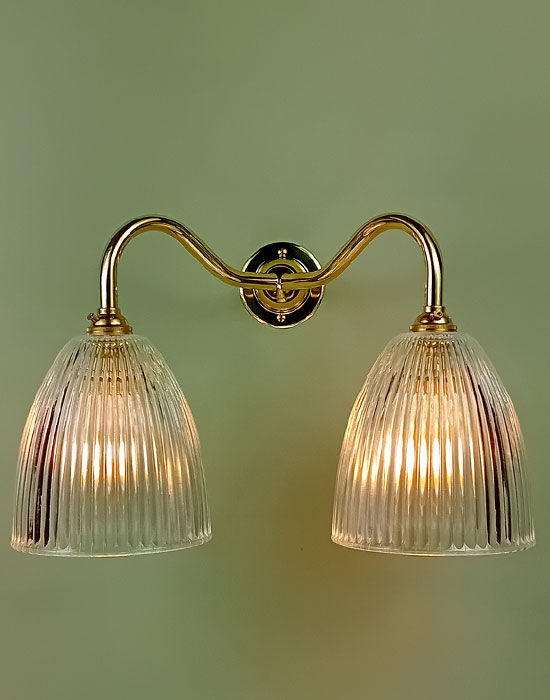
A faithful recreation of an original Simplex design from the 1880s, this double wall light is made in the UK using British components. Its solid brass frame is available in polished, acid-dipped antiqued, or nickel-plated finishes.
The double elongated prismatic shades offer excellent light diffusion, reducing glare while maintaining a crisp, refined aesthetic. Fully recyclable and crafted using traditional techniques, this fixture balances period charm with modern functionality.
The double swan neck light is a very simple, unadorned traditional design that has served as a candle sconce in the 18th century, through gas lights of the 19th century and then electric wall lights throughout the 20th century and into the 21st . It is understated in its simple, unadorned style whether used as shown in our photographs or, if you fancy, as a good uplighter. Its components are made, either, in Birmingham or Northern Ireland.
Inspired by original Simplex designs from the 1880s, this double wall light is assembled in the UK using high-quality British components. The solid brass frame, available in polished, acid-dipped antiqued, or nickel-plated finishes, makes it a versatile choice for both period and contemporary interiors.
Fitted with double elongated prismatic shades, this fixture enhances both form and function. The textured glass diffuses light evenly while adding a striking industrial elegance. Crafted in the UK, it blends heritage craftsmanship with timeless practicality.
We recommend the use of modern LED bulbs and, if used, there is no restriction on its power. If old, filament (incandescent) bulbs are used then a maximum of 40w is recommended.
Prismatic Shades - 'Holophane'
During the early 1890s Andre Blondel, a French engineer and physicist, known for his work in electrical research and an attache to the Lighthouses and Beacons Service, and Spiridion Psaroudaki, a Greek engineer, conceived an idea in a Paris laboratory to cover a glass globe with horizontal glass prisms properly positioned to control light. Patents were awarded to the two inventors in Europe and, upon the granting of US Patent 563836 in 1893, an American, Otis A. Mygatt was introduced to this work. He saw the potential for both domestic and industrial lighting and began to collaborate with Blondel and Psaroudaki.
The advantages of prismatic shades very quickly became clear to a European public demanding brighter light. The prisms effectively focused the dim bulbs output to produce clear, bright, clean illumination and proved very popular in shops, schools, factories, lighthouses and homes. So much so that Mygatt bought the worldwide rights to Blondel and Psaroudaki's invention in 1894 and formed the Holophane Glass Company in 1898 in London to capitalise on his purchase. That same year Mygatt transferred the company to No.1 Broadway, New York.
The term 'Holophane' was derived from the Greek - 'Holos' and 'Phanein' - to contrive the meaning 'to appear completely luminous'. In 1900 Holophane was manufacturing a large range of globes and reflectors and described them thus: [they are made of] 'perfectly clear glass with prisms scientifically constructed in such a manner as to both direct the rays of light in downward and outward directions'.
Height: 25cm
Width: 35cm
Projection: 22cm